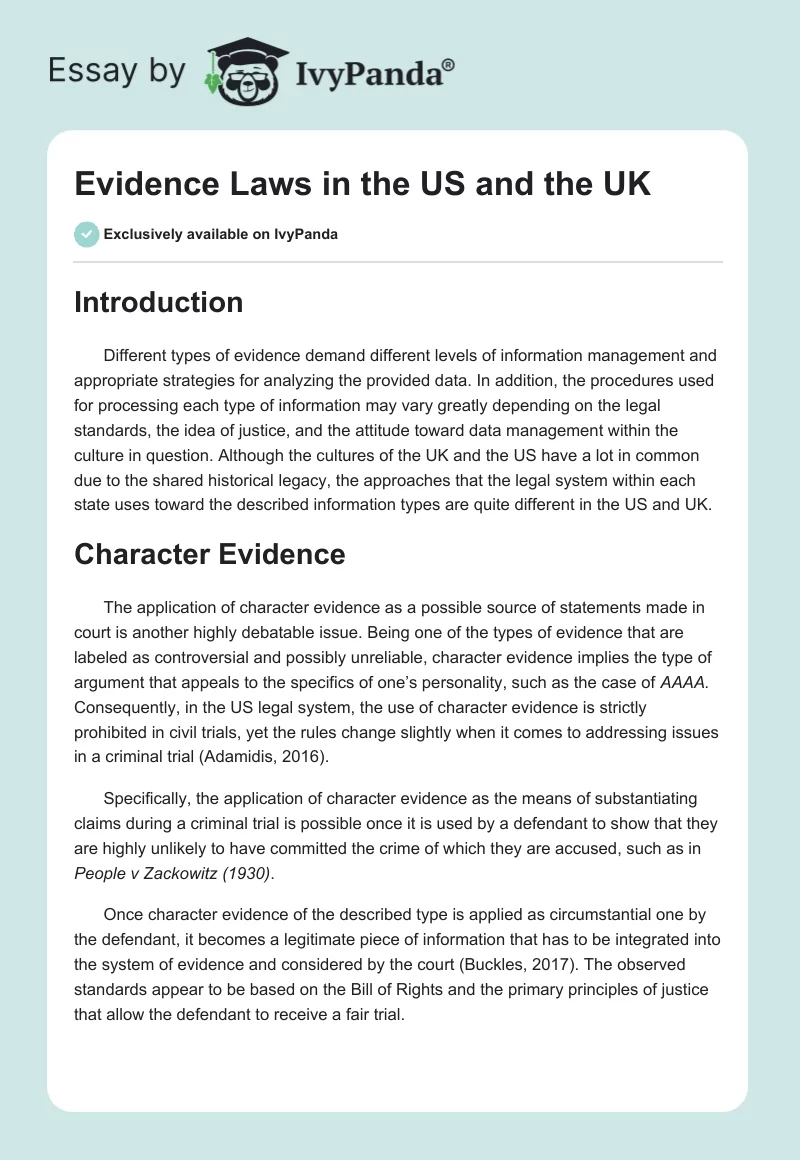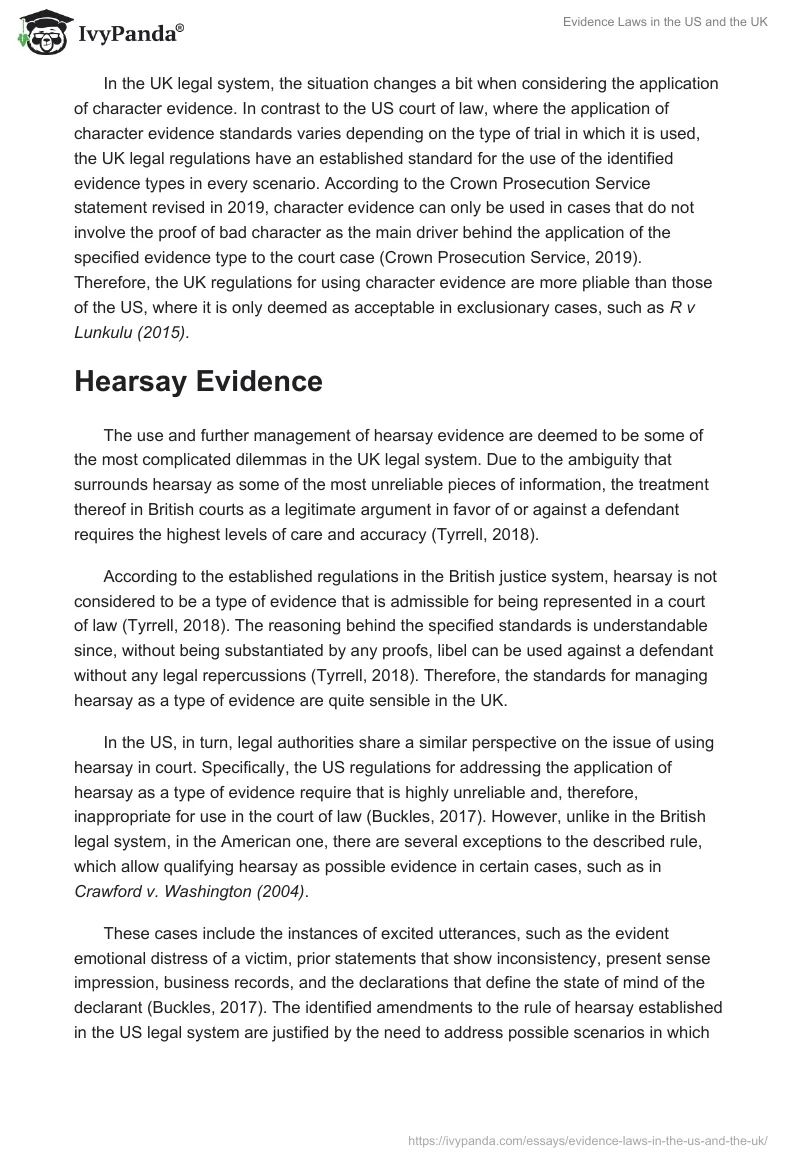Introduction
Different types of evidence demand different levels of information management and appropriate strategies for analyzing the provided data. In addition, the procedures used for processing each type of information may vary greatly depending on the legal standards, the idea of justice, and the attitude toward data management within the culture in question. Although the cultures of the UK and the US have a lot in common due to the shared historical legacy, the approaches that the legal system within each state uses toward the described information types are quite different in the US and UK.
Character Evidence
The application of character evidence as a possible source of statements made in court is another highly debatable issue. Being one of the types of evidence that are labeled as controversial and possibly unreliable, character evidence implies the type of argument that appeals to the specifics of one’s personality, such as the case of AAAA. Consequently, in the US legal system, the use of character evidence is strictly prohibited in civil trials, yet the rules change slightly when it comes to addressing issues in a criminal trial (Adamidis, 2016).
Specifically, the application of character evidence as the means of substantiating claims during a criminal trial is possible once it is used by a defendant to show that they are highly unlikely to have committed the crime of which they are accused, such as in People v Zackowitz (1930).
Once character evidence of the described type is applied as circumstantial one by the defendant, it becomes a legitimate piece of information that has to be integrated into the system of evidence and considered by the court (Buckles, 2017). The observed standards appear to be based on the Bill of Rights and the primary principles of justice that allow the defendant to receive a fair trial.
In the UK legal system, the situation changes a bit when considering the application of character evidence. In contrast to the US court of law, where the application of character evidence standards varies depending on the type of trial in which it is used, the UK legal regulations have an established standard for the use of the identified evidence types in every scenario. According to the Crown Prosecution Service statement revised in 2019, character evidence can only be used in cases that do not involve the proof of bad character as the main driver behind the application of the specified evidence type to the court case (Crown Prosecution Service, 2019). Therefore, the UK regulations for using character evidence are more pliable than those of the US, where it is only deemed as acceptable in exclusionary cases, such as R v Lunkulu (2015).
Hearsay Evidence
The use and further management of hearsay evidence are deemed to be some of the most complicated dilemmas in the UK legal system. Due to the ambiguity that surrounds hearsay as some of the most unreliable pieces of information, the treatment thereof in British courts as a legitimate argument in favor of or against a defendant requires the highest levels of care and accuracy (Tyrrell, 2018).
According to the established regulations in the British justice system, hearsay is not considered to be a type of evidence that is admissible for being represented in a court of law (Tyrrell, 2018). The reasoning behind the specified standards is understandable since, without being substantiated by any proofs, libel can be used against a defendant without any legal repercussions (Tyrrell, 2018). Therefore, the standards for managing hearsay as a type of evidence are quite sensible in the UK.
In the US, in turn, legal authorities share a similar perspective on the issue of using hearsay in court. Specifically, the US regulations for addressing the application of hearsay as a type of evidence require that is highly unreliable and, therefore, inappropriate for use in the court of law (Buckles, 2017). However, unlike in the British legal system, in the American one, there are several exceptions to the described rule, which allow qualifying hearsay as possible evidence in certain cases, such as in Crawford v. Washington (2004).
These cases include the instances of excited utterances, such as the evident emotional distress of a victim, prior statements that show inconsistency, present sense impression, business records, and the declarations that define the state of mind of the declarant (Buckles, 2017). The identified amendments to the rule of hearsay established in the US legal system are justified by the need to address possible scenarios in which hearsay may be true and provide essential information relevant to the well-being of the plaintiff.
Opinion Evidence
Being another quite controversial source of information for representing it in court, opinion evidence is treated differently in the UK and US legal systems. As its name suggests, opinion evidence embraces the range of information that witnesses represent as their personal opinions as opposed to hard evidence (Adam, 2016). In its pure form as the information represented as a personal point of view of a witness, opinion evidence is equally dismissed in both British and American courts (Adam, 2016).
However, in the British legal system, the notion of an expert opinion has recently been introduced into the range of information types that could be reviewed in court (Adam, 2016). In 2009, the concept of the expert opinion was summarized in the following way: “even if the scientific basis is sufficiently reliable, the evidence is not admissible unless it is within the scope of evidence an expert can properly give” (Milroy, 2017, p. 522). Therefore, there are clearly outlined boundaries for the use of opinion evidence in the British court of law.
In contrast to the approach used in the UK legal system toward opinion evidence, American courts consider the use of opinion evidence as a possibility. Specifically, the U.S. Supreme Court states that a witness’s credibility can be supported or questioned at any time once a relevant testimony is provided, such as in Marcum v. Adventist Health System/West (2008) (U.S. Supreme Court, 2017).
However, at the same time, the current U.S. regulations state that the evidence that supplies positive information are only acceptable in specific cases: “evidence of truthful character is admissible only after the witness’s character for truthfulness has been attacked” (U.S. Supreme Court, 2017, p. 12). Therefore, the differences in the perception of opinion evidence can be regarded as the foundational characteristics of the US and UK justice systems.
Conclusion
Despite the presence of numerous similarities between the premise based on which the American and British justice systems are founded, there are substantial differences in regard to how different types of evidence are processed within the legal system of each country.
The observed differences do not suggest that one of the systems is less efficient than another, yet they outline the uniqueness of each framework. As a result, in the US and the UK legal systems, different levels of suspicion can be observed toward the same piece of evidence, which defines the outcomes of the court proceedings. Furthermore, the differences observed in the American and British legal systems point to the uniqueness of fairness perception in each of the justice systems. Overall, the approaches to evidence represented in the British and American legal environments allow managing the difficulties connected to the management of the information of different reliability levels.
References
Adam, C. (2016). Forensic evidence in court: Evaluation and scientific opinion. New York, NY: John Wiley & Sons.
Buckles, T. (2017). Laws of evidence. Boston, MA: Cengage Learning.
Crawford v. Washington 541 U.S. 36 (2004).
Crown Prosecution Service. (2019). Bad character evidence. Web.
Marcum v. Adventist Health System/West, 345 Or 237, 243 (2008).
Milroy, C. M. (2017). A brief history of the expert witness. Academic Forensic Pathology, 7(4), 516-526.
People v Zackowitz 254 NY 192, 197 (1930).
R v Lunkulu EWCA Crim 1350 (2015).
Tyrrell, H. (2018). Human rights in the UK and the influence of foreign jurisprudence. London, UK: Bloomsbury Publishing.
U.S. Supreme Court. (2017). Federal rules of evidence. Web.


